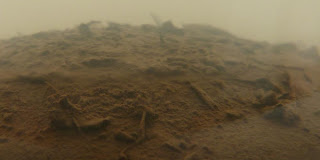Artistic soil is the most inauthentic soil
I took this sample from the lawn between Boijmans Museum and the Dutch National Architecture Museum in the center of Rotterdam. Now that I've been looking at soil more regularly I recognize the color and texture well. It can be found on many public lawns and parks in the city. Often it is mixed with garbage and dog shit.
It is a mixture of sand, clay and peat and it is quite characterless. I think it has been mixed, remixed and reworked many times. Uninteresting color and texture, really tired looking, like the sad brown you get when you mix too many colors, something to overlook. I have no idea where it came from. But looking at the dramatic history of this place, it cannot be virgin soil.
Dramatic history - restless soil
The whole area around the museum was reworked during the construction of the museum and the surrounding streets. It's difficult to determine the local geology from this photograph and at first sight it looks like wet heavy clay but the heaps in the foreground might also be wet sand. Notice the Paradijskerk (Paradise Church) and the Nieuwe Binnenweg in the background for orientation.
Then during the war, after the bombardment of Rotterdam and during the German occupation air raid shelters and defensive trenches were constructed in this area. And also during the war vegetables were grown in this area. (This is real survival in the city, not the fashionable modern urban foraging.) Notice the tower of Boijmans Museum in the background for orientation. And the soil in the pictures already looks like a mixture of soil types.
Attempt at analysis
I'm getting better at it. This time I didn't forget to add something for a sense of scale. Soil is a fractal. It is difficult to estimate the scale at which a picture was taken.
It is easy to see the different components of the soil, the sand grains, the clay dust covering everything and the organic fragments from the peat.The organic fragments float in water - roots and other small pieces of old wood.
Very fine clay settles on everything when the sample is mixed with water. Again scientifically irrelevant - but poetically interesting. Soil and water makes beautiful underwater landscapes, like lost civilizations. And maybe this soil contains authentic memories of Rotterdam.
Some old pictures are from the Rotterdam City archive. So I assume they are public domain, but I'm quite willing to remove them if this is against the regulations. I really like the Rotterdam archive and I've spent a few pleasant hours there searching for weird books on Rotterdam.
The air shelter trenches + Another picture from a different side
I don't know where I got the pictures of the vegetable harvest and the construction of the museum from. I've had them on my computer for two years.









No comments:
Post a Comment